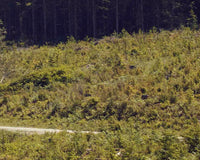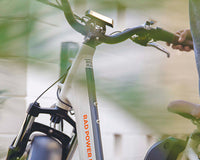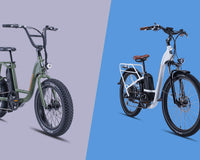Throughout the month of February, we’re using our platform to celebrate the movement towards mobility for all and to feature those who’ve helped progress bicycling as an accessible and inclusive form of transportation and recreation.
The following is a personal essay by Stephanie Puello, Pearl Izumi ambassador and founder and co-leader of the Denver, Colorado, chapter of Black Girls Do Bike. She began cycling in her native Miami during her senior year in college, and two years later became the first Black woman on record to complete an unsupported ride of the Trans-America Trail.
By Stephanie Puello
In the summer of 2016, I daringly -- and unexpectedly -- rode my bike across the country. I spent 101 days on the Trans-America Trail, pedaling 4,468 miles from Virginia to Oregon.
And still, I am reluctant to refer to myself as a “cyclist.”
When I say this ride was unexpected, I mean that I had no previous knowledge about the route, much less any desire to do it. I had never completed a tour of any length before, nor did I know anyone personally that had completed one -- or frankly, that would have any interest in completing a tour. Any way you slice it, this ride was outside of my wheelhouse.
My partner introduced me to the Trans-America Trail and was going to embark on the journey alone after we finished grad school, but his light prodding got the best of me and ultimately I decided to join him. I have something of an audacious spirit -- impulsive yet calculated, intrepid yet methodical. The grandeur of the adventure and rarity of the opportunity was what sparked my interest. Timing and circumstance were also on my side: I was ready to graduate and eager to move on from the job I had. But everything about this trail and bike touring in general was unfamiliar territory.
I’d venture to say that I was as unfamiliar with this space as it was with me.
Cycling was not a part of my upbringing in Miami. It was not something people did in my community or in other communities I frequented. We did not have bike-safe infrastructure or neighborhood bike shops. If I did see someone on a bike, they were usually riding out of necessity rather than exercise or recreation. I didn’t even see a lycra-clad road cyclist until I was in high school.
Until I was introduced to cycling by a friend in college, it was foreign to me. My friend and I went to the same high school but had very different upbringings. He was solidly middle class and had a different perspective on fun, recreation, and activities that were within his reach. He had both a fixed-gear and a mountain bike and rode often with his family.
Even after he introduced me to cycling, it was still something I associated with affluence, exclusion, elitism, and men. Although this was not explicitly communicated to me, nor did I experience direct discrimination from anyone within the cycling community at the time, these were the undertones the scene effused.
Here’s why. I come from a low-income background and an enduringly segregated city. Spatial disparities meant my upbringing was nature-deprived. Though my neighborhood was culturally rich, there were access barriers to parks, green spaces, well-resourced recreational facilities, and walking and cycling trails. Access to recreation typically meant traveling to another neighborhood.
It’s a common experience for many Black, Latine, Indigenous, and low-income families. There is a strong association between access to recreation and race/income. Groups with less access to physical or outdoor exploration may develop a truncated perspective concerning the spaces we belong in. This is what Dr. George Lipsitz, a Black studies professor, describes as both the racialization of space and the spatialization of race. Centuries of discrimination and harassment means that those historically excluded from wealthier and well-resourced neighborhoods and spaces may develop a distinct epistemology and sense of disconnectedness to nature and outdoor recreation.
This leads many of us to internalize that nature and the outdoors is for white people, or as Dr. Jason Byrne, a professor of human geography and planning, puts it: we equate “green” with “white.” Through the systematic creation of exclusionary areas, marginalized communities may count themselves out of spaces associated with whiteness or affluence and may confine themselves to areas where they feel safe from being targeted or surveilled. And the de facto gatekeepers of these spaces or activities -- the bike advocates, brands, shop owners, community group leaders -- reinforce these notions of not belonging, curbing the potential for more inclusive participation.
This is why we so urgently need to push for inclusion within the cycling community.
It is not enough to not be discriminatory -- the community needs to be anti-discriminatory. Being anti-discriminatory requires an active, intentional, and sustained commitment to eliminating the barriers for access and to supporting and advocating for the underrepresented folks that do enter these spaces. This commitment has to acknowledge a wider breadth of view and experience: Many barriers to cycling, such as cost, can hinder participation for anyone (not just minoritized or low-income groups), but the disparities that these groups face are disproportional compared to their white or affluent counterparts.
 (Photo credit: Austin McClain)
(Photo credit: Austin McClain)Making History
Part of this acknowledgment is developing historical consciousness. Dr. Anthony Kwame Harrison, a professor and sociologist, explains how “Structural and symbolic forces combine to produce racialized discourses of belonging and geographies of exclusion." He mentioned this in the context of skiing, but it’s applicable to other white-dominated sports like cycling as well.
It is incumbent upon the gatekeepers to recognize that minoritized groups have historically been physically excluded, banned, and segregated in recreational spaces. More reprehensibly, like with Major Taylor, they have also been subjected to hostility and even assault.
Acknowledging this historical and cultural complexity is fundamental to fostering a sense of collective responsibility to knock down these barriers -- even if we may not have played an active role in creating them. We would be remiss to underestimate the staying power of exclusion and how these notions of belonging are entrenched in our psyche, as Dr. Carolyn Finney explains in her seminal book, Black Faces, White Spaces. It’s history that has socially construed activities like cycling as “white activities," no different than sailing, snow sports, hockey, golf, lacrosse, and others. And what the gatekeepers have done (and have not done) to chip away at these misconceptions informs, reinforces, and normalizes these boundaries of belonging.
Make a Plan
We need to drive urgency around building inclusion into cycling. We need to recognize that the lack of diversity in cycling is not by happenstance or disinterest -- it is systematized. Changing the climate within the sport will require a keen awareness of how we may, even implicitly, perpetuate exclusion. As the founder and co-leader of the Denver chapter of Black Girls Do Bike, I advocate strongly for representation. Despite the barriers, there are plenty of people of color, women, femmes, low-income individuals, and people with disabilities enjoying cycling. But there is a prevalent lack of representation in media and marketing of non-dominant enthusiasts by bike brands, apparel brands, and retailers.
Sharing a few pictures of non-white cyclists on social media will not be a panacea. It is important for those that work in cycling to purposefully recruit and involve underrepresented folks in every aspect of their organization – from product design to marketing, customer service, brand management, and recruiting. Outside of the industry, it is also important for those within the community to make an effort to engage underrepresented cyclists. Race directors, event organizers, bike shop owners, and club leaders should make it their mission to engage in targeted outreach to amplify their programs to a more diverse swath of potential athletes and enthusiasts.
Moreover, with affordability being a dominant barrier to cycling, those with the means can contribute money, time, skills, experience, and gear to underserved communities -- and youth -- to help increase the number of people that take up cycling for fun, fitness, sport, or transportation -- for life.
Developing programs, like bike-share or school-based programs, can lead to more engagement with cycling and can embed a strong culture of cycling in those communities.
Sharing the Road
Improved infrastructure is important for creating a safer and more inclusive cycling community as well. Protected bike lanes, bike-only paths, and bike racks are essential, but it goes beyond that. Black, Brown, and low-income people are more likely to live in a community without sidewalks, they’re not prioritized when it comes to fixing roads or servicing streetlights, and often live near high-speed, high-traffic roads. So even if cost were not a barrier, safety certainly is. This lack of safety is exacerbated for women, femmes, and transgender folks who may justifiably fear being harassed or assaulted while on a bike.
Making cycling more inclusive will require a multi-pronged, holistic approach. The suggestions I’ve outlined are not exhaustive; they are a start. The cycling community should recognize that it is a microcosm of society, and as we engage in the current national moment of reckoning around racial injustice, the cycling community should similarly reckon with its own distinct history of racism, classism, and sexism. If members and gatekeepers commit to continued learning and maintain cultural humility, we can better serve, showcase, and uplift diversity in cycling.
Enduring income, health, transportation, and environmental disparities are an indictment on our institutional priorities, but that does not mean we should bury our heads in the sand. Our community can do a lot to make cycling both more inclusive and equitable. As a space I am actively invested in, I am committed to seeing it become more inclusive, welcoming, accessible, and representative.
Perhaps then I will not be so reluctant to self-describe as a “cyclist.”
Cover photo credit: Jack Todd






